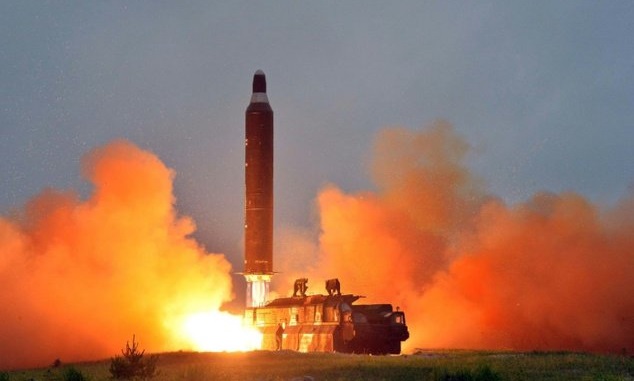
Seoul, South Korea | AFP | South Korea and the United States fired off missiles Wednesday simulating a precision strike against North Korea’s leadership, in response to a landmark ICBM test described by Kim Jong-Un as a gift to “American bastards”.
Tuesday’s launch — acknowledged as an intercontinental ballistic missile by Washington — marked a milestone in Pyongyang’s decades-long drive for the capability to threaten the US mainland with a nuclear strike, and poses a stark foreign policy challenge for Donald Trump.
The US president had dismissed the idea of the North possessing a working ICBM, vowing it “won’t happen”, but independent experts said the missile could reach Alaska or even further towards the continental US.
Trump has recently used a series of Twitter outbursts to criticise China, the North’s sole major ally and economic lifeline, over its failure to rein in the nuclear-armed state
In the latest sign of growing friction in US-China relations he lashed out at Beijing Wednesday, pointing to a surge in its trade with North Korea as evidence that US reliance on Beijing to pull rank on Pyongyang was misplaced.
“Trade between China and North Korea grew almost 40% in the first quarter. So much for China working with us – but we had to give it a try!” Trump tweeted.
Amid international condemnation of the ICBM test, South Korean and US military forces launched short-range ballistic missiles of their own less than 24 hours afterwards from the peninsula into the Sea of Japan.
Both weapons homed in on their target, the South’s Joint Chiefs of Staff said, “displaying the capability of a precision strike against the enemy headquarters in times of emergency”.
– ‘Serious provocation’ –
The South’s new President Moon Jae-In, who backs bringing Pyongyang to the negotiating table, said the North’s “serious provocation required us to react with more than just a statement”.
The US and South Korea are in a security alliance, with 28,500 US troops stationed in the South to protect it.
Their language is likely to infuriate Pyongyang, which says it needs nuclear weapons to defend itself against the threat of invasion and has been subjected to multiple sets of UN sanctions over its atomic and missile programmes.
The launches came hours after a joint appeal by the presidents of China and Russia for all sides to exercise restraint and ease tensions.
Moon later urged Beijing and Moscow to back international pressure on Pyongyang and “raise their awareness that the speed of the North’s nuclear and missile development is fast”.
“I believe China especially holds the key,” he said, in comments reported by the Yonhap news agency.
While he reiterated support for dialogue, he said “we cannot but be concerned of a possible armed conflict”.
Disagreement on how best to respond will complicate discussions at the UN, where the Security Council was to hold an emergency session later Wednesday after Secretary-General Antonio Guterres condemned the North’s launch as a “dangerous escalation”.
– ‘New escalation’ –
After personally overseeing the test, the North’s leader Kim Jong-Un “said American bastards would be not very happy with this gift sent on the July 4 anniversary”, the official Korean Central News Agency reported.
Breaking into peals of laughter, KCNA said, he added: “we should send them gifts once in a while to help break their boredom”.
Kim had inspected the Hwasong-14 missile and “expressed satisfaction, saying it looked as handsome as a good-looking boy and was well made”.
Questions remain over the precise capabilities of the weapon, but footage on the North’s state television Wednesday showed the first stage separating from the device and falling away.
KCNA said it had a carbon composite nose cone that could carry a “large, heavy nuclear warhead” and survive the harsh conditions of re-entry into the Earth’s atmosphere — including “heat reaching thousands of degrees centigrade” — to “accurately hit the target”.
The missile only travelled little more than 900 kilometres (560 miles) to come down in the Sea of Japan, but the altitude it reached — more than 2,800 kilometres according to Pyongyang — demonstrated it can travel far further.
South Korea’s Defence Minister Han Min-koo put its range at 7,000 to 8,000 kilometres — far enough to put US Pacific Command in Hawaii within reach.
US Secretary of State Rex Tillerson strongly condemned the launch, saying: “As we, along with others, have made clear, we will never accept a nuclear-armed North Korea.”
But experts said that particular red line had already been crossed.
“The window for negotiating denuclearisation is closed,” Jeffrey Lewis, an expert in nuclear non-proliferation, told AFP.
“The big point is that we have to accept North Korea with a nuclear-armed ICBM.”
 The Independent Uganda: You get the Truth we Pay the Price
The Independent Uganda: You get the Truth we Pay the Price



